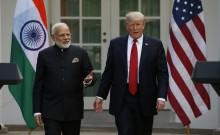![[Representational image] Karnataka to end power deficit](https://data1.ibtimes.co.in/en/full/649357/karnataka-end-power-deficit.jpg?h=450&l=50&t=40)
A consortium consisting of the US Energy Department, India's Ministry of Science and Technology and "industry partners" from India will pool in $30 million — or approximately Rs 190 crore — over five years to advance the power grid in the South Asian nation.
According to an official statement from the US Department of Energy (DOE), the initiative is supported by the department's Office of Electricity Delivery and Energy Reliability. The statement adds that the initiative "builds on the department's commitment to fostering the reliable, resilient, and secure delivery of electricity needed for strong US national security, economic growth, and global leadership, as well as furthering DOE's collaboration with India under the US-India Partnership to Advance Clean Energy (PACE)."
The news of the deal comes just days before Prime Minister Narendra Modi is slated to visit the US. He is expected to discuss a number of issues with US President Donald Trump, and climate change — along with the role clean energy will play in it — will possibly be among them.
US Energy Secretary Rick Perry has said about the initiative: "This new consortium demonstrates US and Indian commitments to ensuring access to affordable and reliable energy in both countries. We know that continued grid innovation will promote economic growth and energy security in the United States and India."
How it benefits India
Now, it seems that although US President Donald Trump — a known climate-sceptic — has pulled out of the Paris agreement, the US agencies are still looking for cleaner energy.
"The US-India collAborative for smart diStribution System wIth STorage (UI-ASSIST) was selected as the new consortia for Smart Grid and Energy Storage under the US-India Joint Clean Energy Research and Development Centre (JCERDC)," said the DOE statement.
Through the JCERDC, US installations and national laboratories will be expected to contribute their expertise and capabilities as India expands energy access to remote areas, improves its grid reliability and resilience, and strengthens its energy security.
![[Representational image] Power line](https://data1.ibtimes.co.in/en/full/646600/power-line.jpg?h=450&l=50&t=40)
"In turn, US participants will gain insight from India's grid modernisation efforts – a potential export market for US equipment worth billions of dollars – as well as promote researcher access to India's grid operational experience," said the US DOE statement.
Who are involved, and how?
The US DOE has pledged $7.5 million to the initiative, while India's Ministry of Science and Technology will match the amount, bringing the corpus to $15 million. Then, the "industry partners" will chip in, and that will take the total to $30 million.
![[Representational image] Dollar](https://data1.ibtimes.co.in/en/full/652014/dollar.jpg?h=450&l=50&t=40)
The American team of UI-ASSIST is led by Washington State University and consists of MIT, Texas A&M University, University of Hawaii, Idaho National Laboratory, Lawrence Berkeley National Laboratory, Snohomish County (WA) Public Utility District, Avista, Burns and McDonnell, ETAP Operation Technology, ALSTOM Grid/GE Grid Solutions, Clean Energy Storage, ABB, Philadelphia Industrial Development Corporation, and the National Rural Electric Cooperative Association (NRECA).
On the Indian side, the team will be led by Indian Institute of Technology (IIT) Kanpur, and include IIIT Delhi, IIT Madras, IIT Roorkee, IIT Bhubaneswar, and The Energy and Resources Institute (TERI) New Delhi.








